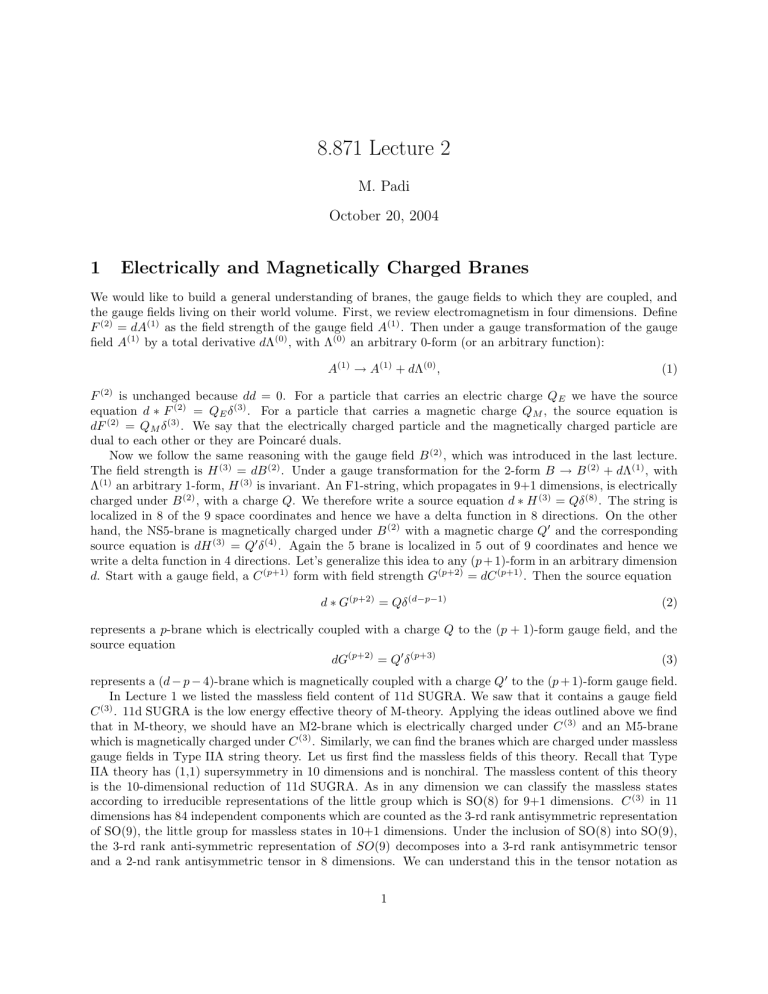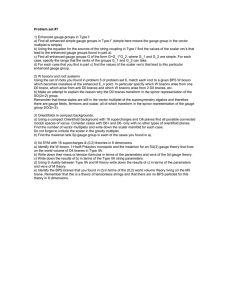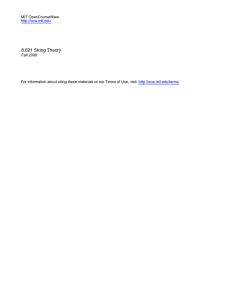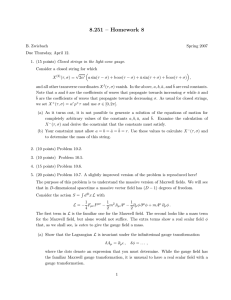8.871 Lecture 2 1 M. Padi

8.871
Lecture 2
M.
Padi
October 20, 2004
1 Electrically and Magnetically Charged Branes
We would like to build a general understanding of branes, the gauge fields to which they are coupled, and the gauge fields living on their world volume.
First, we review electromagnetism in four dimensions.
Define
F (2) = dA (1) as the field strength of the gauge field A (1) .
Then under a gauge transformation of the gauge field A (1) by a total derivative d � (0) , with � (0) an arbitrary 0-form (or an arbitrary function):
A
(1)
� A
(1)
+ d �
(0)
, (1)
F
(2) is unchanged because dd = 0.
For a particle that carries an electric charge Q
E equation d � F
(2) = Q
E
λ
(3) .
For a particle that carries a magnetic charge Q
M we have the source
, the source equation is dF
(2) = Q
M
λ
(3) .
We say that the electrically charged particle and the magnetically charged particle are dual to each other or they are Poincar´e duals.
The
Now field we follow strength the is H same
(3) = reasoning dB (2) .
with
Under the a gauge gauge field B (2) , which was introduced in the last lecture.
transformation for the 2-form B � B (2) + d � (1) , with
� (1) an charged arbitrary under B
1-form,
(2) , with
H a
(3) is invariant.
An F1-string, which propagates in 9+1 dimensions, is electrically charge Q .
We therefore write a source equation d � H (3) = Qλ (8) .
The string is localized in 8 of the 9 space coordinates and hence we have a delta function in 8 directions.
On the other hand, the NS5-brane is magnetically charged under B
(2) with a magnetic charge Q � and the corresponding source equation is dH
(3) = Q � λ
(4) .
Again the 5 brane is localized in 5 out of 9 coordinates and hence we write a delta function in 4 directions.
Let’s generalize this idea to any ( p + 1)-form in an arbitrary dimension d .
Start with a gauge field, a C
( p +1) form with field strength G
( p +2) = dC
( p +1) .
Then the source equation d � G
( p +2) = Qλ
( d
− p
− 1) (2) represents a p -brane which is electrically coupled with a charge Q to the ( p + 1)-form gauge field, and the source equation dG
( p +2)
= Q � λ
( p +3)
(3) represents a ( d − p − 4)-brane which is magnetically coupled with a charge Q � to the ( p + 1)-form gauge field.
In Lecture 1 we listed the massless field content of 11d SUGRA.
We saw that it contains a gauge field
C (3) .
11d SUGRA is the low energy effective theory of M-theory.
Applying the ideas outlined above we find that in M-theory, we should have an M2-brane which is electrically charged under C
(3) and an M5-brane which is magnetically charged under C
(3) .
Similarly, we can find the branes which are charged under massless gauge fields in Type IIA string theory.
Let us first find the massless fields of this theory.
Recall that Type
IIA theory has (1,1) supersymmetry in 10 dimensions and is nonchiral.
The massless content of this theory is the 10-dimensional reduction of 11d SUGRA.
As in any dimension we can classify the massless states according to irreducible representations of the little group which is SO(8) for 9+1 dimensions.
C
(3) in 11 dimensions has 84 independent components which are counted as the 3-rd rank antisymmetric representation of SO(9), the little group for massless states in 10+1 dimensions.
Under the inclusion of SO(8) into SO(9), the 3-rd rank anti-symmetric representation of SO (9) decomposes into a 3-rd rank antisymmetric tensor and a 2-nd rank antisymmetric tensor in 8 dimensions.
We can understand this in the tensor notation as
1
follows: we start with C
µ�� in 10+1 dimensions and pick (for example) � = 10.
Then µ and � can be anything except 10.
That leaves us with a 2-form in 9+1 dimensions which we call B (2) .
We can also have
�, µ, � = 10
3-form has
(but
�
3 constrained to be antisymmetric).
= 56 components and the 2-form has
Then
�
2 we end up with
= 28 components.
We can check this decomposition by computing 28 + 56 = 84.
Similarly, the graviton decomposes into g ab a 3-form
(traceless in 9+1 and dimensions.
symmetric), g
The a (10) and g
(10)(10)
, where a, b = 10.
These objects have 35, 8 and 1 degrees of freedom respectively.
A similar computation can be done for the gravitino, �
µ
, The results are tabulated here:
SO (9) ∗ SO (8)
C : 84 � 56 v
→ 28 = [3] + [2] g : 44 � 35 → 8 v
→ 1 = (2) + [1] + [0]
�
µ
: 128 � 56 s
→ 56 c
→ 8 s
→ 8 c
The notation here is that square brackets [ ] denote antisymmetric tensors whereas round brackets ( ) denote symmetric traceless tensors.
The number inside the brackets is the rank of the tensor.
The subscript v, s, c means the vector representation, the spinor representation and the complex conjugate spinor representation, respectively.
These subscripts are used since for SO(8) there is a triality that acts on the 8 dimensional and the 56 dimensional representations and we therefore have three different representations of the same dimension which we distinguish by these subscripts.
We now look at the bosonic massless fields to determine the kinds of branes that can exist in Type
IIA theory.
Note that there are three kinds of forms.
The 3-form couples electrically to a D2-brane and magnetically to a D4-brane.
The 2-form, B (2) , couples electrically to the F1 string, and magnetically to the
NS5-brane.
(One might ask why B (2) couples to the fundamental string and NS5-brane, not the D1-brane and D5-brane.
Indeed, there is no such distinction if we are just looking at the supergravity multiplet re duced to 10 dimensions.
But in perturbative string theory, D p -branes must carry Ramond-Ramond charges, and so we can distinguish them from NS-branes and F-strings.) Finally, the 1-form in equation (6) couples electrically to a D0-brane and magnetically to a D6-brane.
(4)
(5)
(6)
(7)
Exercise: Repeat this analysis for Type IIB theory.
List the massless fields and find out what types of branes are present in Type IIB.
We can relate the branes of M-theory to the branes of Type IIA string theory via S-duality.
M-theory on the
M
10
× S
1
M2-brane is S-dual wraps to one
Type of its
IIA own theory on dimensions
M
10 on
, where the S 1 ,
M it j is is an dual arbitrary to an F1 j -dimensional string in Type manifold.
IIA.
If
When instead we use dimensional reduction on M-theory, the M2-brane will reduce to a D2-brane.
Similarly, if the M5-brane wraps around the circle, it becomes a D4-brane in Type IIA, but it dimensionally reduces to the NS5-brane.
Just to complete the picture, we’ll briefly go over the massless multiplet in string theories with 16 supercharges, and thus deduce the types of branes in the Type I and heterotic theories.
First, the gravity multiplet contains the graviton, g, which has
8 · 9
2
− 1 = 35 components.
Then there is the 2-form B (2) which has 28 components as usual.
The dilaton ψ adds one more degree of freedom.
We also have a spinor � c with 8 components and a spinor with a vector index, � c
µ
(the gravitino), which has 56 components.
The vector
In the multiplet
Type I consists theory, we of the will vector A therefore
µ
, which has 8 components, and � , a chiral spinor we denote 8 s find a D1-brane (electrically coupled to B
(2) ) and the
.
D5-brane
(magnetically coupled to B
(2) ).
Similarly, in heterotic theories, we have an F1-string and NS5-brane.
In addition to these objects we also have small instantons which are branes that are present in any theory that has non-abelian massless gauge fields.
An instanton is an object which is localized in 4 space coordinates and therefore in 9+1 dimensions it will be a 5 brane.
The Type I string theory has a gauge group SO (32) and the two Heterotic theories have gauge groups SO (32) and E
8
× E
8
, respectively.
As a result we have two additional instanton
5 branes together with what we listed above: the SO (32) small instanton and the E
8 small
2
2 Central Charges and Branes
The existence of branes (solitonic solutions) and the central charges in the supersymmetry algebra are intimately connected.
Central charges are due to non-zero boundary terms that appear when computing the conserved supercharges for topologically nontrivial states, like branes.
For example, in 11d SUGRA, we can have the following maximal extension to the supersymmetric algebra:
{ Q r
, Q s
} sym
=
=
=
P
µ
+ Z
� 11
1
�
�
1
11 �
(5)
+
+
�
+ Z
11 �
(2)
�
5
11 �
5
+
� 11 �
+
�
2
11
9
�
= 11 + 55 + 462
= 528
(8)
Note that 528 =
32 · 33
2
, because the LHS of (8) is a symmetric 32 × 32 matrix.
The 5-form on the RHS corresponds to the charge of the M5-brane.
The 2-form corresponds to the M2-brane.
To get this result, we could also decompose (32 � 32) sym
, the symmetrized tensor product of spinor representations of SO(11), into the direct sum of vector representations of SO(11).
We find that (32 � 32) sym
= 11 → 55 → 462.
Now we can further decompose this into representations of SO(10) by doing dimensional reduction, and find almost the full list of objects in Type IIA theory.
We find that the 2-form B
µ� becomes B
µ (10)
, a 1-form, and B ab
( a, b = 10) a 2-form in 10 dimensions.
These correspond to the F1-string and the D2-brane.
The 1-form P
µ becomes a 1-form in 10 dimensions and a scalar P
10
.
The scalar corresponds to a D0-brane.
Similarly, the
5-form decomposes into a 5-form and 4-form in 10 dimensions.
These are the NS5 and D4-branes.
(Note that the D6-brane and D8-brane are missing in this analysis.) Furthermore, all these objects are BPS states: they break half the supersymmetries in the theory.
They also saturate the BPS bound, which roughly means that the tension (or energy density) is equal to the absolute value of the charge on the brane.
3






